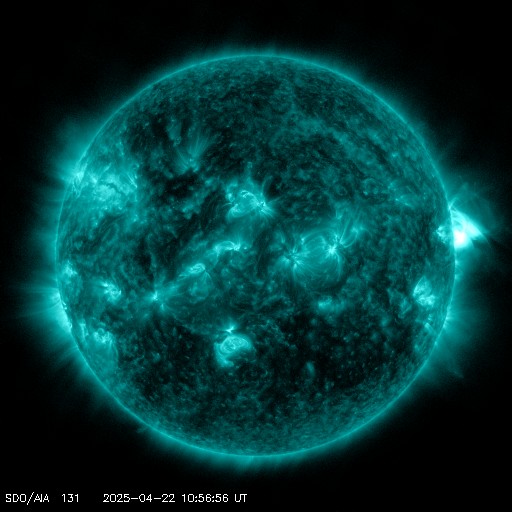Viewing archive of Wednesday, 2 April 2003
Solar activity report
Any mentioned solar flare in this report has a scaling factor applied by the Space Weather Prediction Center (SWPC). Because of the SWPC scaling factor, solar flares are reported as 42% smaller than for the science quality data. The scaling factor has been removed from our archived solar flare data to reflect the true physical units.
Report of Solar-Geophysical Activity 2003 Apr 02 2200 UTCPrepared by the NOAA © SWPC and processed by SpaceWeatherLive.com
Joint USAF/NOAA Report of Solar and Geophysical Activity
SDF Number 092 Issued at 2200Z on 02 Apr 2003IA. Analysis of Solar Active Regions and Activity from 01-2100Z to 02-2100Z
Solar activity was at low levels. There were 4 minor
C-class flares from Regions 321 (N07W40) and 324 (S12W21).
IB. Solar Activity Forecast
Solar activity is expected to be low.
There is a small chance for an isolated M-Class flare from Regions
321 (N07W40), 323 (S07W56), 324 (S12W21), or 325 (N10E04).
IIA. Geophysical Activity Summary 01-2100Z to 02-2100Z
The geomagnetic field was at unsettled to active levels. The high
speed stream that began on 30 March has gained slightly in strength
to nearly 580 km/sec. Intermittently southward Bz has
generated disturbed periods. The greater than 2 MeV electrons at
geosynchronous orbit reached high levels.
IIB. Geophysical Activity Forecast
The geomagnetic field is
expected to be at quiet to minor-storm levels due to the continuing
high speed stream, and potential for southward Bz. The high speed
stream should diminish tomorrow, and the geomagnetic field should
end the day at quiet levels.
III. Event Probabilities 03 Apr to 05 Apr
| Class M | 30% | 30% | 30% |
| Class X | 05% | 05% | 05% |
| Proton | 01% | 01% | 01% |
| PCAF | green | ||
IV. Penticton 10.7 cm Flux
Observed 02 Apr 158 Predicted 03 Apr-05 Apr 155/155/150 90 Day Mean 02 Apr 135
V. Geomagnetic A Indices
Observed Afr/Ap 01 Apr 011/012 Estimated Afr/Ap 02 Apr 021/019 Predicted Afr/Ap 03 Apr-05 Apr 015/015-012/012-010/010
VI. Geomagnetic Activity Probabilities 03 Apr to 05 Apr
| A. Middle Latitudes | |||
|---|---|---|---|
| Active | 40% | 30% | 25% |
| Minor storm | 15% | 10% | 10% |
| Major-severe storm | 05% | 05% | 05% |
| B. High Latitudes | |||
|---|---|---|---|
| Active | 45% | 40% | 35% |
| Minor storm | 20% | 10% | 10% |
| Major-severe storm | 10% | 05% | 05% |
All times in UTC
Latest news
Latest forum messages
JHelioviewer Tips and Settings 28100 year cycle-Centennial Gleissberg Cycle (CGC) 3Incoming & Unnumbered Active Regions 1804Ask your obscure/"stupid" space weather questions. 373Growth of Cycle 25 832
More topicsSupport SpaceWeatherLive.com!
A lot of people come to SpaceWeatherLive to follow the Sun's activity or if there is aurora to be seen, but with more traffic comes higher server costs. Consider a donation if you enjoy SpaceWeatherLive so we can keep the website online!

Space weather facts
| Last X-flare | 2025/03/28 | X1.1 |
| Last M-flare | 2025/04/22 | M1.3 |
| Last geomagnetic storm | 2025/04/21 | Kp5+ (G1) |
| Spotless days | |
|---|---|
| Last spotless day | 2022/06/08 |
| Monthly mean Sunspot Number | |
|---|---|
| March 2025 | 134.2 -20.4 |
| April 2025 | 121 -13.2 |
| Last 30 days | 114 -22.8 |



